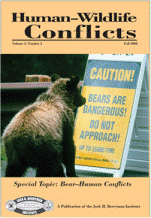Wildlife Damage Management, Internet Center for
Date of this Version
Fall 2009
Abstract
I hope that someday, we will be able to quantify the lost-opportunity costs associated with human–wildlife conflicts. Until that day, I hope that wildlife biologists and other people who help to make air travel safer have the satisfaction of knowing that what they do is important. They help people live better, safer, and more enjoyable lives. I cannot think of a higher calling than that. In tribute to them, I am pleased that this issue of Human–Wildlife Conflicts features several articles on the topic of bird–aircraft collisions. These include studies examining techniques that can reduce the danger of bird–aircraft collisions by modifying conditions at the airport and its general vicinity to make them less attractive to birds (Ball 2009, Bernhardt et al. 2009, Linnell et al. 2009, Hart and Allan 2009, Seamans et al. 2009). Other bird-strike articles in this issue delve into the issue of collecting and maintaining accurate wildlife-strike data (Dolbeer 2009, Dove 2009, Klope et al. 2009, Peurach et al. 2009) and the responsibilities of airport managers (Dale 2009).


Comments
Published in Human–Wildlife Conflicts 3(2):157–158, Fall 2009. Published and copyright (where applicable) by Jack H. Berryman Institute http://www.berrymaninstitute.org/journal/index.html